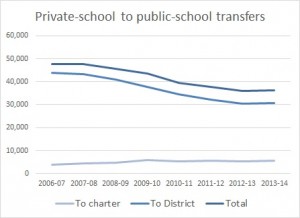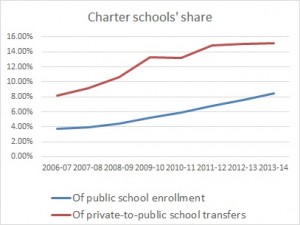
Florida charter schools continue to attract a disproportionate number of students who leave the state’s private schools for public alternatives, a new batch of state statistics shows.
The state’s rapidly growing charter schools have attracted a growing share of students who transferred from private schools to public ones, according to enrollment surveys.
During the 2013-14 school year, the most recent for which the data are available from the Florida Department of Education, more than 36,000 students left private schools for public schools, and 5,475 went to charters.
Charters enrolled slightly more than 15 percent of the students who transferred from private schools, while they enrolled about 8.5 percent of public school students as whole.
That school year, private school enrollment increased slightly, private school scholarship programs grew substantially, and charter schools grew to enroll their largest-ever share of public-school students. Total private-to-public transfers, and the proportion who went to charters, both held relatively steady from the year before.
The details may help shed light on the changing landscape of school choice, and on the factors that shape parents’ decisions about where to enroll their kids. Recent research has suggested that when parents seek options beyond their zoned schools, some may be agnostic about whether the schools they choose are public or private.
The public schools that drew large numbers of students from private schools tended to have strong academic reputations.

Of 17 public schools that reported more than 100 such transfers, all but two had received A’s or B’s from the state in 2013, the most recent year that might have informed parents’ decisions. One of the exceptions was Volusia County’s South Daytona Elementary, which was rated a D in 2013, but went on to improve by two letter grades and attract some positive press the following year.
Two newly opened Franklin Academy charter schools, meanwhile, reported enrolling a combined 180 private-school students. The schools offer features, like single-gender classes and chess instruction, that parents might previously have only found in private schools.
Florida Virtual School’s two full-time programs were also a popular option, drawing about 390 private-school transfers between them.
We’ll continue probing at these numbers and the past data we explored in an earlier analysis. The 2013-14 data are here. Let us know if you see something interesting.


